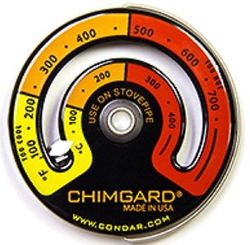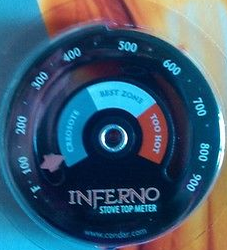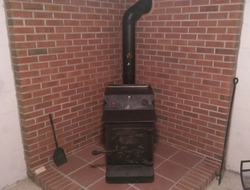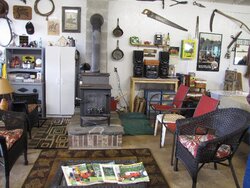Hi guys,
I just started burning some shoulder fires over the last few days to get acclimated to my stove. I have an all nighter mid mo with front draft controls and a key damper in the my flue. This is the first wood stove I've ever owned or operated.
I am getting the hang of it pretty good, getting the air turned down to get a fairly steady burn while keeping it a clean fire. So far so good. I got 2 magnetic thermometers, one for the stove, one for the stack and I double check it with my infra-red thermometer.
What I noticed is, the stove temp gets going good, up in the 500 degree range, and sometimes up in the 600 degree range, the stack however, gets hot much faster. I have found myself having to control the amount of air entering the stove not because my stove was getting too hot, but because my stack was getting too hot.
The stove is built like a tank, I have no fear that it will over heat, and if it did for a short period of time, I would have no doubt it could handle it. The 24ga seamed stove pipe gives me some worry though. My Condar stack thermometer claims that 225 degrees to 475 degrees is the ideal temp for the flue.

My stove top thermometer claims that 400 to 650 is an idea stove temp. I'd like to run at the top end of that, around 600 or 650 to maximize heat output. The problem is, if I try to build the stove temp to 600, my flue temp wants to creep up around 500. I have the key damper set to about half closed but it still occurs, and have the air down enough to keep it controlled, but open enough to try and build the stove temp.

Another thing I noticed, does the paint on the stove pipe have to cure over the course of a few fires just like stove paint? The stove is well cured since it is used but I noticed a faint paint smell and a little smoke off the stove pipe when I had my first fire. Also, when I got the stack to 500 degrees, I noticed the paint on the stove pipe looks duller now, almost like flat black instead of semi gloss. Is this a normal process? I have since kept my stove around 500 degrees which keeps the stove pipe much more happy, around 400 degrees. Once I see that stove pipe temp climbing it really bothers me since its just thin sheet metal with a snap seam.
I know I was long winded but I guess what I'm asking is if you guys experience the same thing, having to adjust the fire based more off of flue temp than the stove temp. I find myself just watching the flue temp, and having to deal with whatever temp the stove happens to be to keep the flue temp happy. Is a 500 degree flue temp nothing to really be worried about or should I really try to keep it at 450 max?
Here is a pic of my setup:

I just started burning some shoulder fires over the last few days to get acclimated to my stove. I have an all nighter mid mo with front draft controls and a key damper in the my flue. This is the first wood stove I've ever owned or operated.
I am getting the hang of it pretty good, getting the air turned down to get a fairly steady burn while keeping it a clean fire. So far so good. I got 2 magnetic thermometers, one for the stove, one for the stack and I double check it with my infra-red thermometer.
What I noticed is, the stove temp gets going good, up in the 500 degree range, and sometimes up in the 600 degree range, the stack however, gets hot much faster. I have found myself having to control the amount of air entering the stove not because my stove was getting too hot, but because my stack was getting too hot.
The stove is built like a tank, I have no fear that it will over heat, and if it did for a short period of time, I would have no doubt it could handle it. The 24ga seamed stove pipe gives me some worry though. My Condar stack thermometer claims that 225 degrees to 475 degrees is the ideal temp for the flue.

My stove top thermometer claims that 400 to 650 is an idea stove temp. I'd like to run at the top end of that, around 600 or 650 to maximize heat output. The problem is, if I try to build the stove temp to 600, my flue temp wants to creep up around 500. I have the key damper set to about half closed but it still occurs, and have the air down enough to keep it controlled, but open enough to try and build the stove temp.

Another thing I noticed, does the paint on the stove pipe have to cure over the course of a few fires just like stove paint? The stove is well cured since it is used but I noticed a faint paint smell and a little smoke off the stove pipe when I had my first fire. Also, when I got the stack to 500 degrees, I noticed the paint on the stove pipe looks duller now, almost like flat black instead of semi gloss. Is this a normal process? I have since kept my stove around 500 degrees which keeps the stove pipe much more happy, around 400 degrees. Once I see that stove pipe temp climbing it really bothers me since its just thin sheet metal with a snap seam.
I know I was long winded but I guess what I'm asking is if you guys experience the same thing, having to adjust the fire based more off of flue temp than the stove temp. I find myself just watching the flue temp, and having to deal with whatever temp the stove happens to be to keep the flue temp happy. Is a 500 degree flue temp nothing to really be worried about or should I really try to keep it at 450 max?
Here is a pic of my setup:



